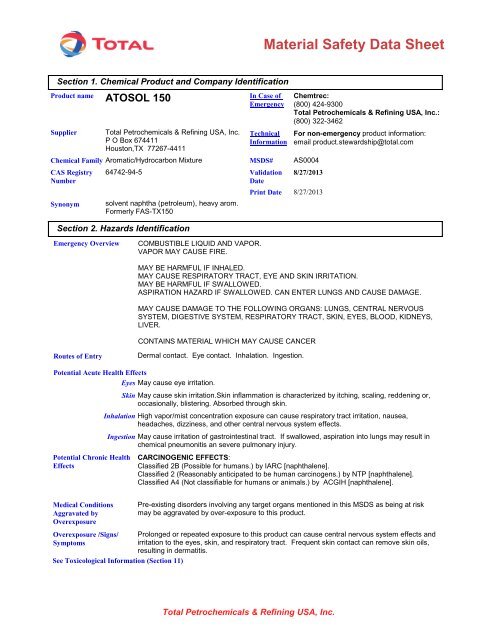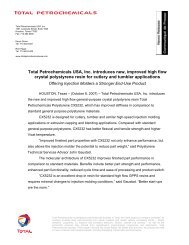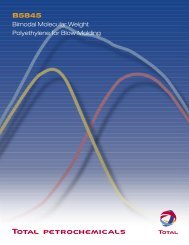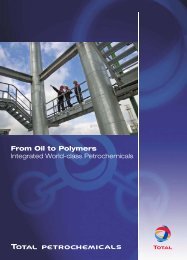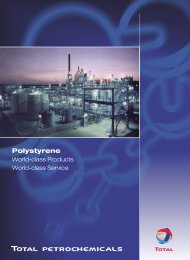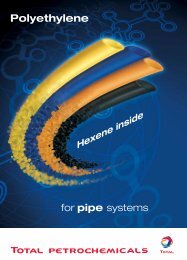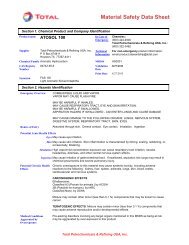Atosol 150 MSDS - Total Petrochemicals USA
Atosol 150 MSDS - Total Petrochemicals USA
Atosol 150 MSDS - Total Petrochemicals USA
You also want an ePaper? Increase the reach of your titles
YUMPU automatically turns print PDFs into web optimized ePapers that Google loves.
ATOSOL <strong>150</strong> Page: 3/8Section 6. Accidental Release Measures_Small Spill and LeakLarge Spill and LeakAbsorb with an inert material and put the spilled material in an appropriate waste disposal.Contain spill and safely stop the flow.Warn personnel to move away.Eliminate all sources of ignition.Ventilate.Absorb with an inert material (sand) and put the spilled material in an appropriate wastedisposal.Do not allow any potentially contaminated water including rain water, runoff from fire fightingor spills to enter any waterway, sewer or drain.Prevent entry into sewers, basements or confined areas; dike if needed.Keep out of waterways.Section 7. Handling and StorageHandlingStoragePut on appropriate personal protective equipment (see Section 8). Eating, drinking andsmoking should be prohibited in areas where this material is handled, stored and processed.Workers should wash hands and face before eating, drinking and smoking. Do not get ineyes or on skin or clothing. Do not breathe vapor or mist. Do not ingest. Use only withadequate ventilation. Wear appropriate respirator when ventilation is inadequate. Do notenter storage areas and confined spaces unless adequately ventilated. Keep in the originalcontainer or an approved alternative made from a compatible material, kept tightly closedwhen not in use. Store and use away from heat, sparks, open flame or any other ignitionsource. Use explosion-proof electrical (ventilating, lighting and material handling) equipment.Use non-sparking tools. Take precautionary measures against electrostatic discharges. Toavoid fire or explosion, dissipate static electricity during transfer by grounding and bondingcontainers and equipment before transferring material. Empty containers retain productresidue and can be hazardous. Do not reuse container.Combustible materials should be stored in a separate safety storage cabinet or room.Keep away from heat.Keep away from sources of ignition.Keep container tightly closed.Keep in a cool and well-ventilated area.Ground all equipment containing material.Keep container dry.Keep in a cool place.All efforts should be made to prevent any leaks or spills. Storage tanks containing should beengineered to prevent contact with water resources, as this material could contaminate thewater resources. Surface spills can reach groundwater through porous soil or crackedsurfaces. The storage tanks should be monitored regularly for leaks. Where spills or leaks arepossible, a comprehensive response plan should be developed and implemented.Section 8. Exposure Controls/Personal ProtectionEngineering ControlsUse only with adequate ventilation. Use process enclosures, local exhaust ventilation or otherengineering controls to keep worker exposure to airborne contaminants below anyrecommended or statutory limits. The engineering controls also need to keep gas, vapor ordust concentrations below any lower explosive limits. Use explosion-proof ventilationequipment. Ensure that eyewash station and safety shower is proximal to the work-stationlocation.Personal ProtectionEyes Safety glasses with side shields.Body Flame retardant clothing covering the entire body.Respiratory Use a MSHA/NIOSH approved respirator or equivalent at high concentrations.Hands Chemical resistant gloves if contact is possible.Feet Shoes.Protective Clothing(Pictograms)<strong>Total</strong> <strong>Petrochemicals</strong> & Refining <strong>USA</strong>, Inc.
ATOSOL <strong>150</strong> Page: 4/8Personal Protection inCase of a Large SpillProduct Name_Splash goggles. Full suit. Vapor respirator. Boots. Gloves. A self contained breathingapparatus should be used to avoid inhalation of the product. Suggested protective clothingmight not be sufficient; consult a specialist BEFORE handling this product.Exposure LimitsSolvent naphtha (petroleum), heavy arom. -1,2-Dimethyl-4-ethylbenzene -1,2,3,5-tetramethylbenzene -1,2,4,5-tetramethylbenzene -1,3-Dimethyl-4-ethylbenzene -1,3-Dimethyl-5-ethylbenzene -1,4-Dimethyl-2-ethylbenzene -1-methyl-3-n-propylbenzene -naphthaleneACGIH TLV (United States, 3/2012). Absorbed through skin.TWA: 10 ppm 8 hours.STEL: 15 ppm 15 minutes.TWA: 52 mg/m³ 8 hours.STEL: 79 mg/m³ 15 minutes.OSHA PEL (United States, 6/2010).TWA: 10 ppm 8 hours.TWA: 50 mg/m³ 8 hours.NIOSH REL (United States, 6/2009).TWA: 10 ppm 10 hours.TWA: 50 mg/m³ 10 hours.STEL: 15 ppm 15 minutes.STEL: 75 mg/m³ 15 minutes.1,4-diethylbenzene -1,2,3-trimethylbenzene ACGIH TLV (United States, 3/2012).TWA: 25 ppm 8 hours.TWA: 123 mg/m³ 8 hours.NIOSH REL (United States, 6/2009).TWA: 25 ppm 10 hours.TWA: 125 mg/m³ 10 hours.1-Methyl-4-propylbenzene -1,2,4-trimethylbenzene ACGIH TLV (United States, 3/2012).TWA: 25 ppm 8 hours.TWA: 123 mg/m³ 8 hours.NIOSH REL (United States, 6/2009).TWA: 25 ppm 10 hours.TWA: 125 mg/m³ 10 hours.2-methylnaphthaleneACGIH TLV (United States, 2011). Absorbed through skin.TWA: 0.5 ppm 8 hours.1,3-diethylbenzene -Consult local authorities for acceptable exposure limits.Section 9. Physical and Chemical PropertiesPhysical State and AppearanceLiquid.ColorOdorMolecular WeightMolecular FormulaBoiling/Condensation PointSpecific GravityVapor PressureVapor DensityVolatilityEvaporation RateVOCSolubility in WaterColorless.Aromatic.Not applicable.Not applicable.182.2 to 210°C (360 to 410°F)0.9 (Water = 1)
ATOSOL <strong>150</strong> Page: 5/8Section 10. Stability and ReactivityStability and ReactivityConditions of InstabilityIncompatibility withVarious SubstancesHazardousDecomposition ProductsHazardousPolymerizationThe product is stable.No additional remark.Section 11. Toxicological InformationToxicity to AnimalsChronic Effects onHumansExtremely reactive or incompatible with strong oxidizing agents._Under normal conditions of storage and use, hazardous decomposition products should notbe produced. In a fire, hazardous decomposition products may be produced.Under normal conditions of storage and use, hazardous polymerization will not occur.Product/ingredient name Result Species Dose Exposuresolvent naphthaLD50 Dermal Rabbit >2 mL/kg -(petroleum), heavy arom.LC50 Inhalation Vapor Rat >590 mg/m3 4 hours1,2,3,5-tetramethylbenzene LD50 Oral Rat 5157 mg/kg -1,2,4,5-tetramethylbenzene LD50 Oral Rat 6700 mg/kg -LD50 Oral Rat 6989 mg/kg -naphthalene LD50 Dermal Rabbit >20 gm/kg -LD50 Dermal Rat >2500 mg/kg -LD50 Oral Rat 490 mg/kg -1,2,4-trimethylbenzene LD50 Oral Rat 5 g/kg -LC50 Inhalation Vapor Rat 18000 mg/m3 4 hours2-methylnaphthalene LD50 Intraperitoneal Rat 1.63 gm/kg -LD50 Oral Rat 1630 mg/kg -CARCINOGENIC EFFECTS:Classified 2B (Possible for humans.) by IARC [naphthalene]. Classified 2 (Reasonablyanticipated to be human carcinogens.) by NTP [naphthalene].May cause damage to the following organs: lungs, central nervous system (CNS), digestivesystem, upper respiratory tract, skin, eyes, blood, kidneys, liver.Other Toxic Effects onHumansSpecial Remarks onToxicity to AnimalsMay be irritating to eyes, skin and respiratory system. Aspiration hazard if swallowed. Canenter lungs and cause damage.NTP concluded based on inhalation studies that there is clear evidence of carcinogenic activityof naphthalene in rats based on increased incidences of respiratory epithelial adenoma (tissuetumors) and olfactory epithelial neuroblastoma (malignant tumors) of the nose.Section 12. Ecological InformationEcotoxicityNot available.Biodegradable/OECD Constituents of this type of aromatic solvent are expected to biodegrade.MobilityConstituents of this type of aromatic solvent are expected to partition between air, water, andsoil.Section 13. Disposal ConsiderationsWaste Information Recover free liquid. Transfer to a safe disposal area in accordance with federal, state, andlocal regulations. The classification of the product may meet the criteria for a hazardous waste.Consult your local or regional authorities.<strong>Total</strong> <strong>Petrochemicals</strong> & Refining <strong>USA</strong>, Inc.
ATOSOL <strong>150</strong> Page: 6/8_Section 14. Transport Information(for domestic bulk shipments, non-bulk shipments may differ)DOT Classification forBulk Shipments (non bulkshipments may differ)Proper Shipping Name/DescriptionUN NumberPacking GroupMarine PollutantCombustible liquidUN1268, Petroleum distillates, n.o.s., Combustible liquid, PGIII RQ (contains naphthalene)orNA1993, Combustible Liquid, n.o.s. (Heavy Aromatic Petroleum Solvent), PGIII RQ (containsnaphthalene)UN1268IIINot listed in Appendix B to 49CFR172.101Hazardous SubstancesReportable QuantitySpecial Provisions forTransportTDG ClassificationIMO/IMDG ClassificationICAO/IATA ClassificationUSCG ProperShipping NameNaphthalene: 100 lbsSee codes as shown in 49 CFR 172.101 column 7.Not available.Not available.Not available.Naphtha: AromaticSection 15. Regulatory InformationHCS ClassificationU.S. Federal RegulationsCombustible liquidCarcinogenTarget organ effectsTSCA 4(a) final test rules: naphthaleneTSCA 8(a) PAIR: naphthaleneUnited States inventory (TSCA 8b): All components are listed or exempted.TSCA 12(b) one-time export: naphthaleneInternational RegulationsSARA 302/304/311/312 extremely hazardous substances: To the best of our knowledge,there are no substances that would be at reportable levels for this regulation in this product.SARA 302/304 emergency planning and notification: To the best of our knowledge, thereare no substances that would be at reportable levels for this regulation in this product.SARA 311/312 <strong>MSDS</strong> distribution - chemical inventory - hazard identification: ATOSOL<strong>150</strong> [solvent naphtha (petroleum), heavy arom.] : Fire hazard, Immediate (acute) health hazard,Delayed (chronic) health hazardSARA 313 Supplier NotificationThis product contains the following EPCRA section 313 chemicals subject to the reportingrequirements of section 313 of the Emergency Planning and Community Right-to-Know Actof 1986 (40 CFR 372 -Table 372.65).Product name CAS number Concentration (%)naphthalene 91-20-3
ATOSOL <strong>150</strong> Page: 7/8DSCL (EEC)CEPA DSL/NDSLInternational ListsState Regulations_CEPA Toxic substances: The following components are listed: Polycyclic aromatichydrocarbonsCanadian ARET: None of the components are listed.Canadian NPRI: The following components are listed: Heavy aromatic solvent naphthaAlberta Designated Substances: None of the components are listed.Ontario Designated Substances: None of the components are listed.Quebec Designated Substances: None of the components are listed.R65- Harmful: may cause lung damage if swallowed.All components are listed or exempted.Australia inventory (AICS): All components are listed or exempted.China inventory (IECSC): All components are listed or exempted.Japan inventory: Not determined.Korea inventory: All components are listed or exempted.Malaysia Inventory (EHS Register): All components are listed or exempted.New Zealand Inventory of Chemicals (NZIoC): All components are listed or exempted.Philippines inventory (PICCS): All components are listed or exempted.Taiwan inventory (CSNN): Not determined.Massachusetts Substances: The following components are listed: NAPHTHALENE; P-DIETHYL BENZENE; TRIMETHYL BENZENE; PSEUDOCUMENE; M-DIETHYL BENZENENew Jersey Hazardous Substances: The following components are listed: NAPHTHALENE;MOTH FLAKES; TRIMETHYL BENZENE; PSEUDOCUMENENew York Acutely Hazardous Substances: The following components are listed:NaphthalenePennsylvania RTK Hazardous Substances: The following components are listed:NAPHTHALENE; BENZENE, 1,4-DIETHYL-; BENZENE, TRIMETHYL-; PSEUDOCUMENE;BENZENE, 1,3-DIETHYL-CALIFORNIA PROP. 65 WARNING: This product contains a chemical or chemicals known tothe state of California to cause cancer, birth defects or other reproductive harm.: naphthaleneSection 16. Other InformationLabel requirements COMBUSTIBLE LIQUID AND VAPOR.VAPOR MAY CAUSE FIRE.MAY BE HARMFUL IF INHALED.MAY CAUSE RESPIRATORY TRACT, EYE AND SKIN IRRITATION.MAY BE HARMFUL IF SWALLOWED.ASPIRATION HAZARD IF SWALLOWED. CAN ENTER LUNGS AND CAUSE DAMAGE.MAY CAUSE DAMAGE TO THE FOLLOWING ORGANS: LUNGS, CENTRAL NERVOUSSYSTEM, DIGESTIVE SYSTEM, RESPIRATORY TRACT, SKIN, EYES, BLOOD, KIDNEYS,LIVER.Hazardous MaterialInformation System(U.S.A.)CONTAINS MATERIAL WHICH MAY CAUSE CANCERHealthFire HazardReactivityPersonal Protection*120National FireProtectionAssociation(U.S.A.)Health120Fire HazardReactivitySpecific HazardReferences-HSDB - Hazardous Substances Data BankChemtox DatabaseValidated on 8/27/2013.Printed 8/27/2013.<strong>Total</strong> <strong>Petrochemicals</strong> & Refining <strong>USA</strong>, Inc.
ATOSOL <strong>150</strong> Page: 8/8Chemtrec:(800) 424-9300<strong>Total</strong> <strong>Petrochemicals</strong> & Refining <strong>USA</strong>, Inc.:(800) 322-3462Notice to ReaderTo the best of our knowledge, the information contained herein is accurate. However, neither the above named supplier nor any of its subsidiaries assumes anyliability whatsoever for the accuracy or completeness of the information contained herein. Final determination of suitability of any material is the soleresponsibility of the user. All materials may present unknown hazards and should be used with caution. Although certain hazards are described herein, wecannot guarantee that these are the only hazards that exist.<strong>MSDS</strong> Name ATOSOL <strong>150</strong> <strong>MSDS</strong> Code ATOSOL<strong>150</strong>25_To obtain an electronic copy of this <strong>MSDS</strong>, please email: product.stewardship@total.com.<strong>Total</strong> <strong>Petrochemicals</strong> & Refining <strong>USA</strong>, Inc.


